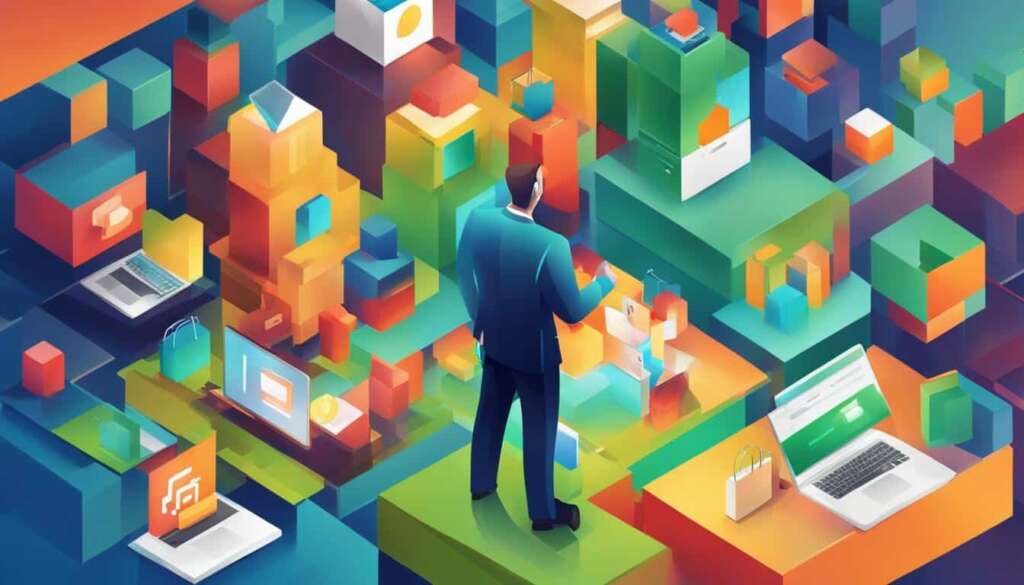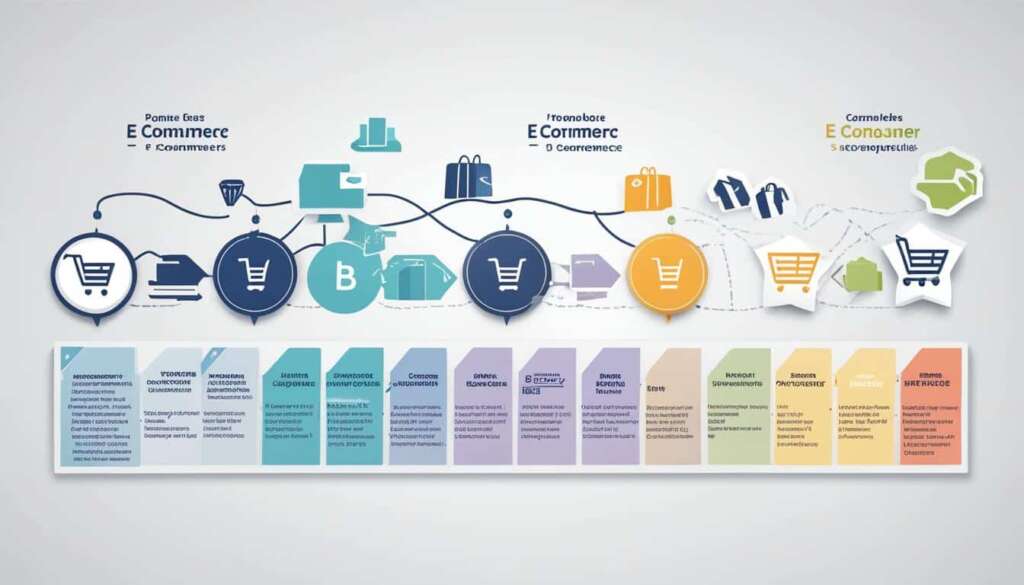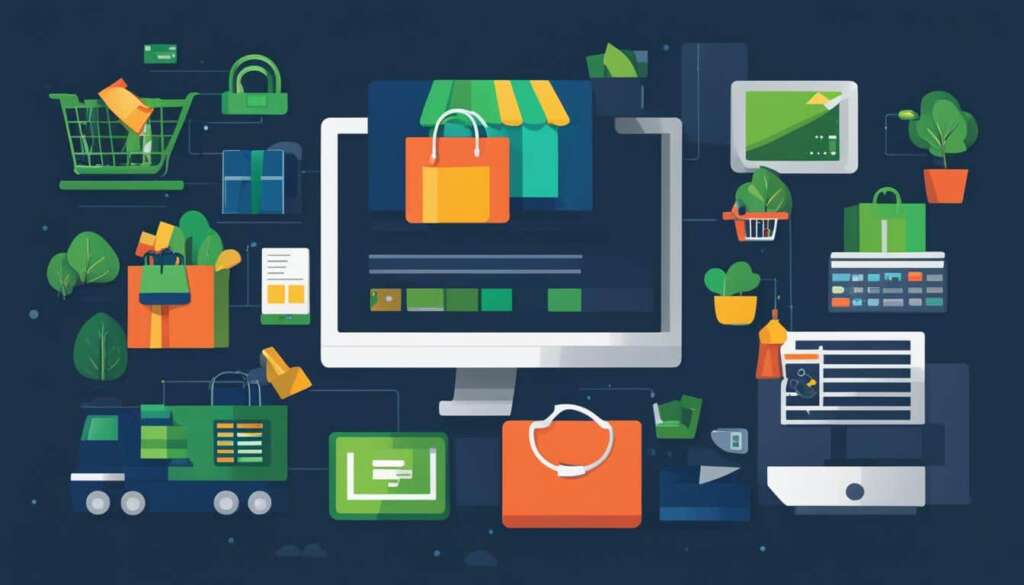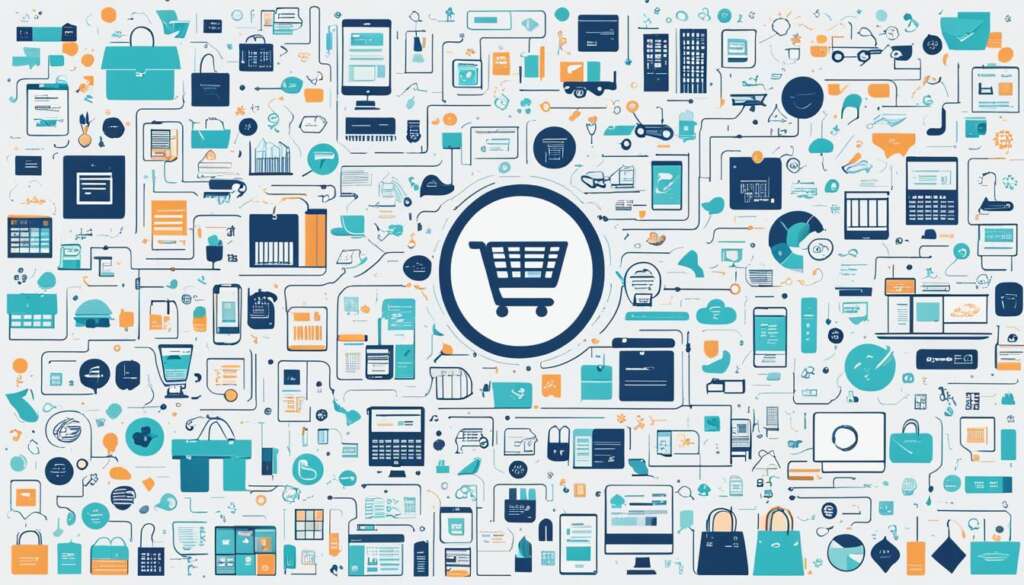Table of Contents
E-commerce, short for electronic commerce, is the buying and selling of goods and services over an electronic network, primarily the internet. It has become an essential part of modern-day commerce, revolutionizing the way people engage in online buying and selling.
Platforms like Amazon and eBay have played a significant role in the growth of e-commerce, providing consumers with a wide range of options and businesses with new avenues for reaching customers. E-commerce encompasses various types of transactions, from B2B and B2C to C2C and C2B, catering to different business models and consumer preferences.
In recent years, e-commerce has experienced remarkable growth, with the COVID-19 pandemic further accelerating its adoption. As traditional brick-and-mortar stores faced lockdowns and restrictions, consumers turned to online shopping for convenience and safety.
E-commerce offers numerous advantages, such as the availability of products and services 24/7, easy accessibility through the internet, and a wide selection of options. It also provides businesses with an international reach, enabling them to sell to customers worldwide.
However, e-commerce also presents challenges, including limited customer service compared to in-person interactions, potential mismatches of expectations due to the inability to physically see or touch products before purchase, and security issues like fraud and counterfeit products.
To achieve success in e-commerce, businesses must consider various factors, such as choosing a reliable e-commerce platform, creating a standout brand and site design, providing a smooth user experience, and implementing a formidable marketing strategy.
This article will delve into the meaning and essence of e-commerce, explain how e-commerce works, explore its different types, and discuss the advantages and disadvantages of engaging in online buying and selling. It will also provide key considerations for e-commerce success, equipping readers with the knowledge and insights necessary to navigate the world of online retail.
Stay tuned as we dive into the exciting world of e-commerce and unveil the secrets to success in the digital marketplace.
What is E-commerce?
E-commerce, also known as electronic commerce, involves the buying and selling of goods and services over an electronic network, primarily the internet. It encompasses various types of transactions, such as B2B, B2C, C2C, and C2B. E-commerce has become synonymous with online retail shopping, with platforms like Amazon and eBay revolutionizing the way people shop. In recent years, the growth of e-commerce has been remarkable, with the COVID-19 pandemic further accelerating its adoption.
E-commerce, short for electronic commerce, refers to the buying and selling of goods and services over an electronic network, primarily the internet.
It includes various types of transactions, including business-to-business (B2B), business-to-consumer (B2C), consumer-to-consumer (C2C), and consumer-to-business (C2B).
“E-commerce has become synonymous with online retail shopping, with platforms like Amazon and eBay revolutionizing the way people shop.”
With the rise of e-commerce, online retail shopping has transformed the traditional retail landscape. Consumers can browse and purchase products from the comfort of their own homes, making it convenient and accessible. The growth of e-commerce has been driven by advancements in technology and the widespread use of the internet. With just a few clicks, consumers can compare prices, read product reviews, and make purchases, all without leaving their homes.
The Evolution of E-Commerce
Over the years, e-commerce has evolved significantly, adapting to changes in consumer behavior and technological advancements.
In the early days of e-commerce, online shopping was seen as a novel concept, and consumers were hesitant to trust online retailers. However, as e-commerce platforms improved security measures, offered reliable payment options, and implemented customer-centric policies, consumer confidence grew.
| Year | Milestone |
|---|---|
| 1995 | Amazon.com, one of the first online marketplaces, launched. |
| 1999 | Alibaba, a Chinese e-commerce conglomerate, founded. |
| 2000 | PayPal introduced as a popular online payment solution. |
| 2005 | YouTube launched, providing a platform for video marketing. |
| 2007 | Apple introduced the iPhone, revolutionizing mobile shopping. |
| 2020 | The COVID-19 pandemic accelerates e-commerce adoption. |
E-commerce has become a global phenomenon, with businesses of all sizes utilizing online platforms to reach customers worldwide. The convenience and accessibility of online retail shopping have attracted consumers, with a wide range of products available at their fingertips.
How Does E-commerce Work?
The e-commerce process involves various components and stages that enable online transactions seamlessly. From accessing an online store to product dispatch, each step plays a critical role in ensuring a smooth e-commerce experience.
Accessing the Online Store
When a customer wants to make a purchase, they begin by accessing the online store through their web browser. Using their preferred device, such as a computer, smartphone, or tablet, they navigate to the store’s website.
Placing an Order
Once on the website, the customer selects the desired products or services and adds them to their virtual shopping cart. They then proceed to the checkout page, where they provide the necessary information, such as shipping address and payment method, to finalize the order.
Communication with the Server
When the order is placed, the customer’s web browser communicates with the server hosting the e-commerce website. This communication ensures that the order data is securely transmitted to the appropriate systems for processing.
Order Manager and Inventory Management
The order data is relayed to a central computer known as the order manager. This order manager acts as the hub that coordinates various tasks, including inventory management and payment processing. It interacts with databases that manage inventory levels, ensuring that products are available for purchase.
Payment Processing
Payment processing applications, such as PayPal, allow the order manager to securely process the customer’s payment. This ensures that the financial transaction is completed smoothly and securely.
Order Validation and Customer Notification
After the payment is processed, the order manager validates the order details to ensure accuracy and availability of the products. Once the order is confirmed, the order manager notifies the customer, providing them with essential information, such as order confirmation and tracking details.
Product Dispatch
The order data, including the customer’s shipping address and product details, is then sent to the warehouse or fulfillment department. This department is responsible for packaging and dispatching the ordered products, ensuring that they reach the customer in a timely manner.
E-commerce Platforms
In addition to standalone e-commerce websites, there are various e-commerce platforms available. These platforms provide online marketplaces, software as a service (SaaS) tools, and open-source tools that facilitate online transactions. They offer additional features and functionalities, making it easier for businesses to set up and manage their e-commerce operations.
In summary, the e-commerce process encompasses accessing an online store, placing an order, communication with the server, order management, inventory management, payment processing, and product dispatch. E-commerce platforms and tools further enhance the e-commerce experience, offering businesses and customers a seamless and efficient way to engage in online transactions.
Types of E-commerce
E-commerce encompasses various types of online transactions, each involving different parties. Understanding these different types is crucial for navigating the world of online retail effectively. The four main types of e-commerce are:
B2B E-commerce
In B2B e-commerce, businesses exchange products, services, or information with other businesses. This type of e-commerce often involves large-scale transactions, such as wholesale purchases between manufacturers and distributors. B2B e-commerce platforms facilitate seamless collaboration and streamline supply chain processes.
B2C E-commerce
B2C e-commerce refers to businesses selling products or services directly to consumers. This type of e-commerce is what most people think of when they envision online shopping. Popular B2C e-commerce platforms like Amazon and eBay allow consumers to browse and purchase a wide range of products from various sellers.
C2C E-commerce
C2C e-commerce enables consumers to trade products, services, and information with each other through online platforms. Online marketplaces like Craigslist and Gumtree facilitate C2C transactions, allowing individuals to sell used items, offer services, or engage in bartering.
C2B E-commerce
C2B e-commerce allows consumers to sell their own products or services to businesses. Examples include freelance platforms like Upwork or Fiverr, where individuals can offer their skills to businesses looking for specific services. C2B e-commerce has gained popularity with the rise of the gig economy.
E-commerce can be classified into different types based on the parties involved in the online transactions: B2B, B2C, C2C, and C2B. Each type brings its own unique characteristics and implications for conducting online business.
Understanding the different types of e-commerce provides insights into the dynamics of online transactions and helps businesses tailor their strategies to target the right audience. A comprehensive understanding of these types of e-commerce is essential for establishing a successful online presence and staying competitive in today’s digital marketplace.
| E-commerce Type | Description |
|---|---|
| B2B E-commerce | The exchange of products, services, or information between businesses. |
| B2C E-commerce | Businesses selling products or services directly to consumers. |
| C2C E-commerce | Consumers trading products, services, and information with each other through online platforms. |
| C2B E-commerce | Consumers selling their own products or services to businesses. |
Advantages of E-commerce
E-commerce has become increasingly popular due to the numerous advantages it offers. Let’s explore some of the key benefits that make e-commerce a preferred choice for businesses and consumers alike.
Around-the-Clock Availability
One of the major advantages of e-commerce is its availability 24/7. Customers can browse and shop at any time, without being limited to store opening hours. Whether it’s early morning or late at night, e-commerce platforms are accessible, ensuring convenience and flexibility for customers.
Accessibility and Wide Selection
E-commerce platforms provide easy accessibility to a wide selection of products and services. With just a few clicks, users can explore an extensive range of offerings from various sellers and brands. This accessibility enables customers to quickly find and compare products, making informed purchasing decisions.
International Reach
E-commerce has a global reach, allowing businesses to sell their products and services to customers from all over the world. This international accessibility expands market opportunities, enabling businesses to tap into new customer bases and expand their reach beyond geographical boundaries.
Speed of Access and Convenience
E-commerce offers a faster and more convenient shopping experience compared to traditional brick-and-mortar stores. Customers can quickly access products and services from the comfort of their own homes or while on the go. With fast loading times and intuitive user interfaces, e-commerce platforms ensure a seamless and efficient shopping journey.
Personalization and Product Recommendations
E-commerce platforms leverage customer data to provide personalized shopping experiences. By analyzing customer preferences and purchase history, e-commerce sites can offer tailored product recommendations, enhancing customer satisfaction and increasing the likelihood of repeat purchases. These personalized recommendations make the shopping experience more engaging and efficient for customers.
| Advantages of E-commerce |
|---|
| Availability |
| Accessibility |
| Speed of Access |
| Wide Selection |
| International Reach |
E-commerce’s availability, accessibility, speed of access, wide selection, and international reach make it a powerful tool for businesses and a convenient shopping platform for consumers. These advantages have propelled e-commerce to the forefront of modern retail, revolutionizing the way we shop and conduct business.

Disadvantages of E-commerce
While e-commerce offers numerous advantages, it is important to acknowledge the potential disadvantages that accompany online shopping. Understanding these drawbacks can help businesses address them effectively and ensure a positive customer experience.
1. Limited Customer Service
One of the main disadvantages of e-commerce is the limited customer service compared to in-person interactions. Customers may not have the same level of personalized assistance and support that they would receive from a salesperson in a physical store. This lack of direct interaction can sometimes lead to a less satisfactory shopping experience.
2. Limited Product Experience
Another drawback is the limitation of physical product experience. Unlike in a brick-and-mortar store, customers in e-commerce cannot physically see, touch, or try on products before making a purchase. This limitation can sometimes result in a mismatch between the customer’s expectations and the actual product.
3. Wait Time for Product Shipping
Although efforts have been made to expedite product delivery, there is still a wait time associated with e-commerce. Customers may have to wait for several days or even weeks for their products to arrive, depending on factors such as location, shipping method, and availability. This wait time can be a source of frustration for customers who need immediate gratification.
4. Security Issues
E-commerce also comes with security concerns, such as fraud and counterfeit products. Online transactions involve sharing personal and financial information, which makes customers vulnerable to potential data breaches or unauthorized access. Maintaining robust security measures and educating customers about online safety is crucial to build trust and mitigate these risks.
“The rise of e-commerce has transformed the way people shop, but it is essential to address the limitations and challenges associated with online retail to ensure a positive customer experience.” – E-commerce expert
To summarize, e-commerce has its share of disadvantages, including limited customer service, limited product experience, wait time for product shipping, and security issues. However, by actively addressing these challenges, businesses can maximize the benefits of online retail and provide a seamless and secure shopping experience for their customers.
Key Considerations for E-commerce Success
Achieving success in e-commerce requires careful consideration of various factors. By focusing on the following key areas, you can build a strong foundation for your online business:
1. Reliable Ecommerce Platform
Choosing a reliable ecommerce platform that aligns with your business needs and provides robust features is crucial. A stable platform ensures smooth website performance, secure transactions, and scalability as your business grows. Look for platforms that offer reliable technical support and regular updates to keep up with industry trends.
2. Standout Brand and Site Design
Creating a standout brand and site design helps establish a strong identity and attract customers. Invest in professional logo design, color schemes, and typography that reflect your brand’s personality. A well-designed website enhances credibility and sets you apart from competitors.

3. Eye-catching Product Photography
High-quality product photography plays a vital role in capturing customers’ attention and driving conversions. Invest in professional photography equipment or hire a skilled photographer to present your products in the best light. Clear, detailed images create trust and allow customers to make informed purchasing decisions.
4. Smooth User Experience
A smooth user experience is crucial for retaining customers and encouraging repeat purchases. Optimize your website for mobile devices, ensure fast loading times, and simplify navigation. Incorporate intuitive search and filtering functionalities to help users find products quickly. A seamless browsing experience builds customer trust and loyalty.
5. Frictionless Checkout
Streamline your checkout process to minimize cart abandonment and maximize conversions. Implement a user-friendly, multi-step checkout flow with clear instructions and progress indicators. Offer multiple payment options and ensure that transaction forms are secure and easy to use. Making the checkout process quick and hassle-free ensures a positive customer experience.
6. Fast and Reliable Order Fulfillment
Delivering orders quickly and reliably is essential for customer satisfaction. Partner with reliable shipping carriers and optimize your order fulfillment process. Implement robust inventory management systems to track stock levels accurately and avoid overselling. Providing timely updates on order status and delivery tracking enhances transparency and builds trust.
7. Formidable Ecommerce Marketing Strategy
An effective ecommerce marketing strategy is critical for driving traffic and conversions. Utilize a mix of paid advertising, SEO optimization, email marketing, and social media promotions to reach your target audience. Leverage analytics tools to measure campaign performance and refine your strategies accordingly. Continuously test and optimize your marketing efforts to stay ahead of the competition.
By considering these key factors, you can build a solid foundation for your e-commerce business and increase your chances of success.
Conclusion
E-commerce has revolutionised the way we conduct business and connect with consumers. It has become an essential component of modern-day commerce, providing convenience, accessibility, and an extensive array of options for both businesses and consumers alike. By harnessing the power of technology and the internet, e-commerce has completely transformed the buying and selling of products and services, opening up endless opportunities for growth and success.
Understanding the fundamentals of e-commerce is vital for navigating the world of online retail effectively. This includes grasping its definition, comprehending the process, familiarising oneself with the various types of e-commerce, and recognising the advantages and challenges it presents. By immersing oneself in these e-commerce essentials, businesses can position themselves strategically and make informed decisions to thrive in the digital marketplace.
Additionally, considering key factors for e-commerce success is crucial. This entails selecting a reliable e-commerce platform tailored to specific business needs, developing a standout brand and site design to make a lasting impression, utilising eye-catching product photography to showcase offerings effectively, and prioritising a smooth user experience and frictionless checkout process to enhance customer satisfaction. Furthermore, fast and reliable order fulfillment, coupled with a formidable e-commerce marketing strategy, are essential for driving traffic, boosting conversions, and maintaining a competitive edge.
In conclusion, e-commerce has transformed the way we conduct business, enabling seamless connections between businesses and consumers worldwide. By understanding the core components of e-commerce and adopting key considerations for success, businesses can leverage this dynamic platform to unlock growth, expand their reach, and thrive in the ever-evolving digital landscape.
FAQ
What is the meaning of e-commerce?
E-commerce, short for electronic commerce, refers to the buying and selling of goods and services over an electronic network, primarily the internet.
What is online buying and selling?
Online buying and selling, also known as e-commerce, involves the exchange of goods and services over an electronic network, primarily the internet.
What is the essence of e-commerce?
E-commerce allows businesses and consumers to engage in transactions online, offering convenience, accessibility, and a wide range of options.
What is the definition of e-commerce?
E-commerce, also known as electronic commerce, involves the buying and selling of goods and services over an electronic network, primarily the internet.
What is electronic network in e-commerce?
An electronic network refers to the internet, which facilitates the exchange of goods and services in e-commerce.
What is online retail shopping?
Online retail shopping is a type of e-commerce where businesses sell products or services directly to consumers through the internet.
How does e-commerce work?
The e-commerce process starts when a customer accesses an online store through their web browser and places an order. The order data is then relayed to a central computer known as the order manager, which interacts with databases managing inventory levels and payment processing applications.
What is a web browser in e-commerce?
A web browser is a software application used by customers to access online stores and browse and purchase products and services.
What is an order manager in e-commerce?
An order manager is a central computer that receives and manages order data in e-commerce, interacting with inventory databases and payment processing applications.
What is inventory management in e-commerce?
Inventory management involves tracking and managing the quantity and availability of products in stock in e-commerce.
What is payment processing in e-commerce?
Payment processing in e-commerce involves the secure handling of customer payments, verification, and transaction completion.
What are the types of e-commerce?
E-commerce can be classified into different types based on the parties involved in the online transactions. These include B2B (business-to-business), B2C (business-to-consumer), C2C (consumer-to-consumer), and C2B (consumer-to-business) e-commerce.
What is B2B e-commerce?
B2B e-commerce refers to the exchange of products, services, or information between businesses online.
What is B2C e-commerce?
B2C e-commerce involves businesses selling products or services directly to consumers through online platforms.
What is C2C e-commerce?
C2C e-commerce enables consumers to trade products, services, and information with each other through online platforms.
What is C2B e-commerce?
C2B e-commerce allows consumers to sell their own products or services to businesses through online platforms.
What are the advantages of e-commerce?
E-commerce offers several advantages, including around-the-clock availability, easy accessibility, a wide selection of products and services, international reach, a faster shopping experience, and personalization based on customer data.
What is the availability advantage of e-commerce?
E-commerce provides around-the-clock availability, allowing customers to browse and shop anytime, regardless of store opening hours.
What is the accessibility advantage of e-commerce?
E-commerce platforms are easily accessible, and users can quickly access a wide selection of products and services from anywhere with an internet connection.
What is the speed of access advantage of e-commerce?
E-commerce provides a faster and more convenient shopping experience compared to traditional brick-and-mortar stores, allowing customers to find and purchase products with just a few clicks or taps.
What is the wide selection advantage of e-commerce?
E-commerce offers a vast range of products and services from different sellers and brands, providing customers with more options to choose from.
What is the international reach advantage of e-commerce?
E-commerce enables businesses to sell to customers worldwide, expanding their reach beyond physical store locations and local markets.
What are the disadvantages of e-commerce?
E-commerce presents some disadvantages, including limited customer service compared to in-person interactions, the inability to physically see or touch products before purchase, wait times for product shipping, and security issues such as fraud and counterfeit products.
What is the limited customer service disadvantage of e-commerce?
Customer service in e-commerce can be limited compared to in-person interactions, as customers may have to rely on online support or communication channels instead of direct assistance.
What is the limited product experience disadvantage of e-commerce?
Customers may not be able to physically see or touch a product before purchase in e-commerce, which can lead to a potential mismatch of expectations compared to in-store shopping.
What is the wait time disadvantage of e-commerce?
In e-commerce, customers may experience wait times for product shipping, although efforts have been made to expedite delivery and provide faster shipping options.
What are the security issues in e-commerce?
Security issues in e-commerce include concerns such as fraud and counterfeit products, which businesses need to address to ensure a positive customer experience.
What are the key considerations for e-commerce success?
Achieving success in e-commerce requires careful consideration of various factors, including choosing a reliable ecommerce platform, creating a standout brand and site design, having eye-catching product photography, providing a smooth user experience, ensuring a frictionless checkout process, maintaining fast and reliable order fulfillment, and implementing a formidable ecommerce marketing strategy.













